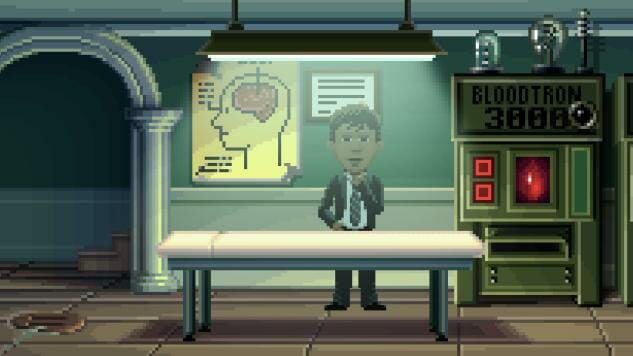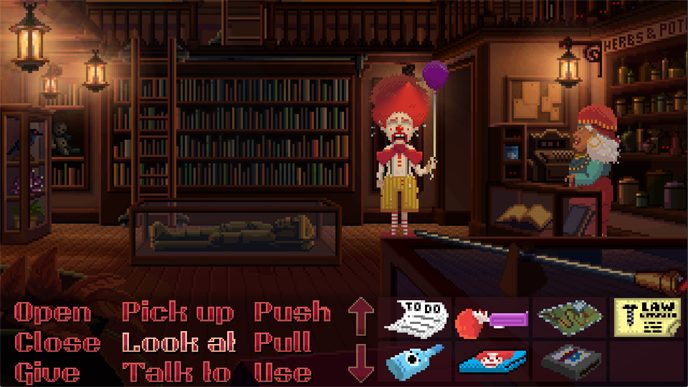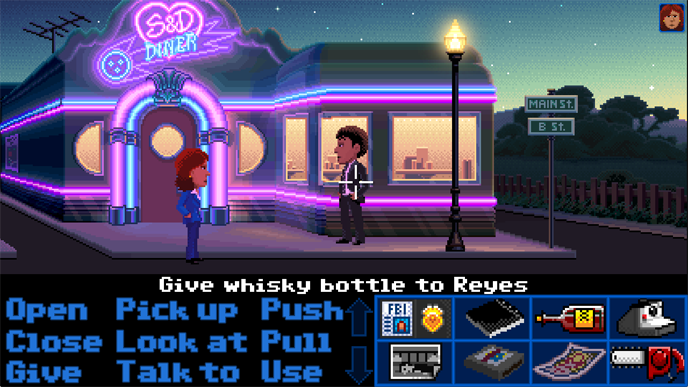Thimbleweed Park’s Wireframe Writing Betrays Its Hefty Puzzles

For the first two hours or so, Thimbleweed Park, the latest game by ex-LucasArts adventure game vets Ron Gilbert and Gary Winnick, convinces players that they are in for a standard murder mystery. It introduces its first two main characters, Agent Ray and Reyes, through snappy banter that feels reminiscent of Mulder and Scully from The X-Files. Ray comments on how the dead body before them is starting to “pixelate”, which Reyes jots down in his journal like an eager student. It was a cute moment, despite the grim situation at hand. I didn’t mind the game proclaiming “We’re in a video game!” so blatantly and so early into the game. There’s nothing wrong with a welcoming wink and nod, as long as it leads to something more.
Seven hours into the game, I find myself in control of five different characters, with access to a variety of locations. The two FBI agents have been relegated to walking inventories, accompanied by an über-geek game designer, a foul-mouthed circus clown, and a ghost. What distinguishes these other characters from their duller counterparts are unique moments of characterization early in the game: Dolores, the game designer, torn between her dreams and her rich uncle’s wishes; Ransome the Clown, whose vitriolic standup leads to his mystical downfall; and Franklin, an inventor whose ambitions and needs are suppressed by his meekness, both in life and death. These moments offer promising glimpses into something deeper than just a murder mystery, hinting at themes about family dysfunction, corporate intrusion, and the boundaries of comedy. However, sadly, all of this is put to the wayside once the ruse is up and the game’s intentions become clear: Thimbleweed Park is more invested in the logical efficiency of its puzzle design and incessant self-indulgent humor than developing any kind of originality and depth in its storytelling.
The former isn’t in and of itself a bad thing. The puzzles in Thimbleweed Park have a pace and structure that effectively correct the meandering, nonsensical design decisions of adventure games of yore. They are all very absurd in nature, but make sense within the universe the game exists in. The puzzles shine most brightly in the first three chapters, during the sections you play as the FBI agents. Their singular united goal of solving a murder case breaks down the task into a series of smaller puzzles, each one rewarding for the journey, not for the punchlines carried through. Exploring the town and talking to its peculiar residents at first feels fresh, genuinely evoking the best of its adventure game ancestry. Fresh enough to make the first signs of pronounced eye-rolling meta humor (“This cut-scene is starting to get long and it’s only going to get longer!”) and pop culture regurgitation seem inoffensive.
Once the gameplay shifts towards working on checklists rather than focused objectives, the mediocrity begins to show itself more clearly. It turns into a formula of passing items between characters who never properly meet or talk to each other, working as one mutually disconnected team. Puzzles grow wider but not deeper, by having the player constantly traverse multiple places for items and clues while abandoning any sense of direction. Environments start to lose their visual and tonal appeal the more they become vessels for nostalgic pandering. Each story revelation becomes a new chance to throw more boiler plate genre clichés into the pot, as if relying on TV murder mystery iconography wasn’t enough. Despite its visual crudeness by today’s standards, Gilbert’s seminal Maniac Mansion evoked B-movie sci-fi with a vivacious playfulness that revealed a genuine love for the subgenre. In Thimbleweed Park, sci-fi and horror are dismantled into various alluring pieces, each one used to desperately keep the player’s attention.
This reliance on basic geek absurdities slowly evolves into a spiteful blend of self-deprecating and self-aggrandizing humor. One minute, the game sarcastically proclaims, “Who the hell wants to be a game designer?”, the next, it proudly explains to the player how it’s totally NOT like those old, ineffective adventure games. These detours into “the plight of the game designer” aren’t so much as looking into the funhouse mirror, but more like gleefully smashing your head into it. All of this is compounded during the final act, where puzzles become easier and very linear, shifting the player’s attention to the fourth wall that will be demolished before them. That early game meta-humor is revealed to have been foreshadowing for the game’s actual narrative intentions. It wholeheartedly gives into trendy video game navel gazing, the kind that has prevailed in the medium ever since Bioshock made telling players they’re playing a game sound like an original revelation.
After the game’s credits finish rolling, we are presented with a Commodore 64 loading screen. To many, this might instill a sense of nostalgia for their youth growing up in this era of video game history. To me, it recalled a small moment early in the game, where Dolores expresses her love for her own C64. Her elated observations display an impassioned investment within the writing. The self-deprecation is, mostly, dropped, and through the tech jargon, we see the same kind of vibrant eagerness that Maniac Mansion had for its own subjects. All these moments, made most effective by the charming voice acting and animations, left me frustrated. Not because they were bad, but because they represented unfulfilled potential.
It wasn’t long ago that Tim Schafer and his team at Double Fine released Broken Age, a game that was, admittedly, one half-terrible adventure game design, but managed to be two parts a powerful tale about family expectations, duty, and heroism, told with Schafer’s signature sense of humanistic humor and warmth. In his own journey of reliving his old LucasArt days, Schafer made a game that not only was funny, but intimate in both its design and writing. In Thimbleweed Park, Gilbert & Co. seem afraid to let their passions truly shine with earnest depth, focusing only on the most superficial aspects of them. In a way, the game succeeds in feeling like relic, though not for the right reasons. It’s caught in a time where its references and plot twists might have been compelling and essential, but now sound like the ramblings of someone trying to catch up and stay relevant within the zeitgeist. For some, none of this matters, as long as the puzzles achieve acceptable levels of fun and logic. And I admit, they game does reach those levels, many times in fact. But if we hope to see this often-maligned genre grow out of the worst parts of its history, we should also set a higher standard for the kind of stories it can tell. Or in Thimbleweed Park’s case, how it tells them and with what amount of conviction.
Thimbleweed Park was developed and published by Terrible Toybox. Our review is based on the PC version. It is also available for PC, Xbox One and PlayStation 4.
Stuart Arias is a freelance writer based in Chicago. You can find his daily ramblings on music and video games @Vida_Honrada. For longer ramblings, check out his blog.

